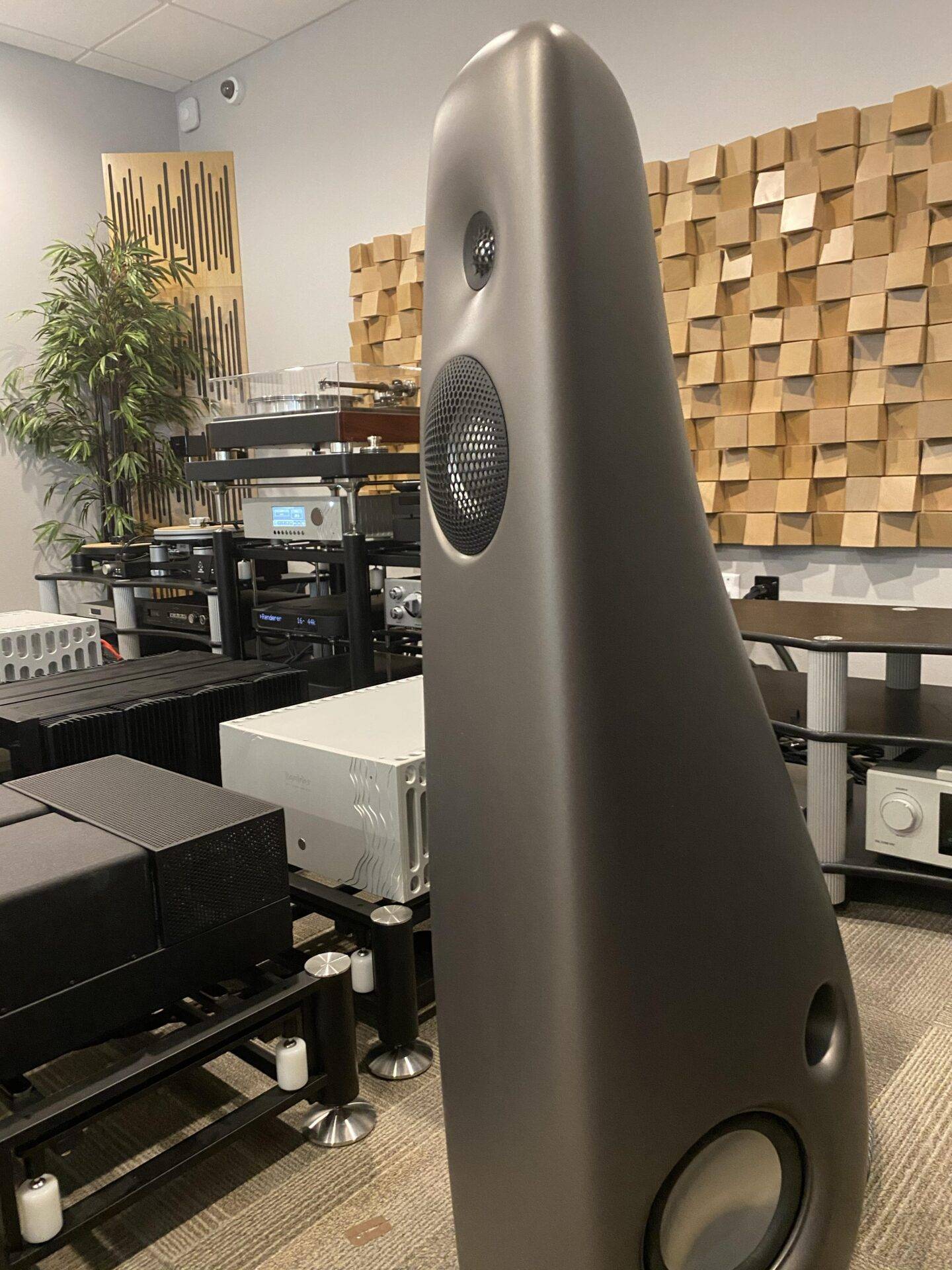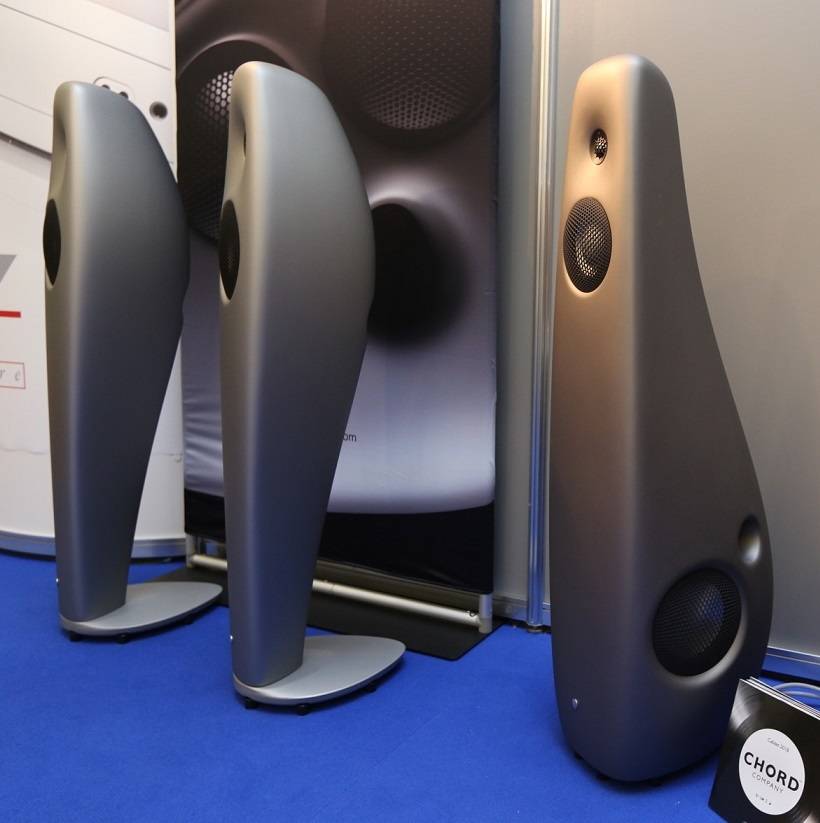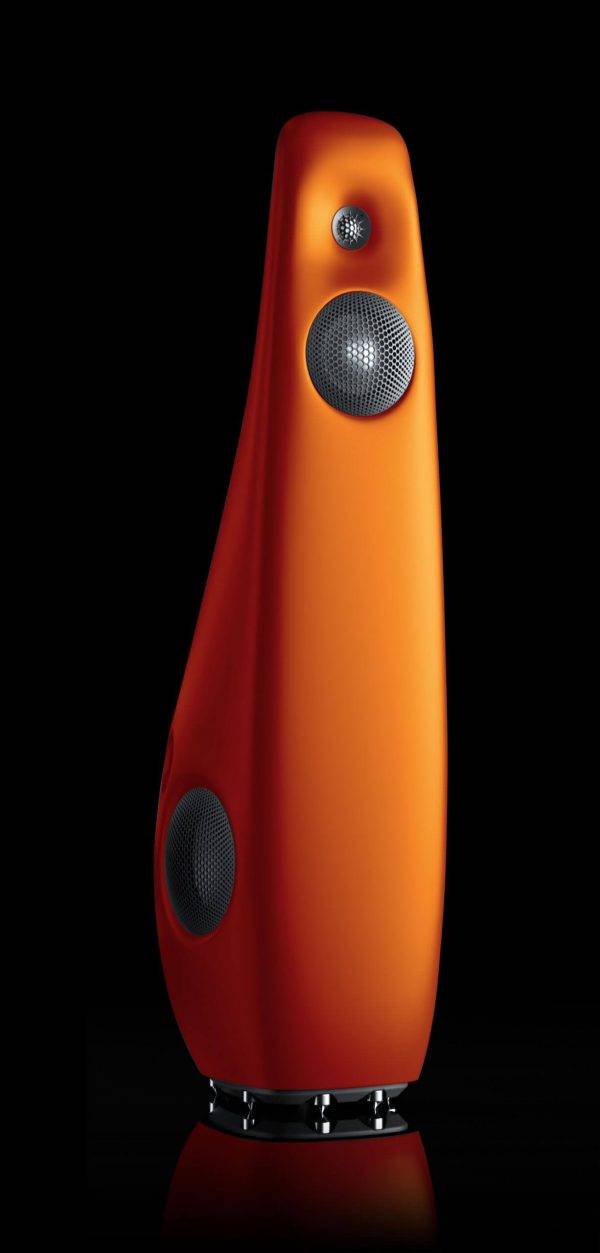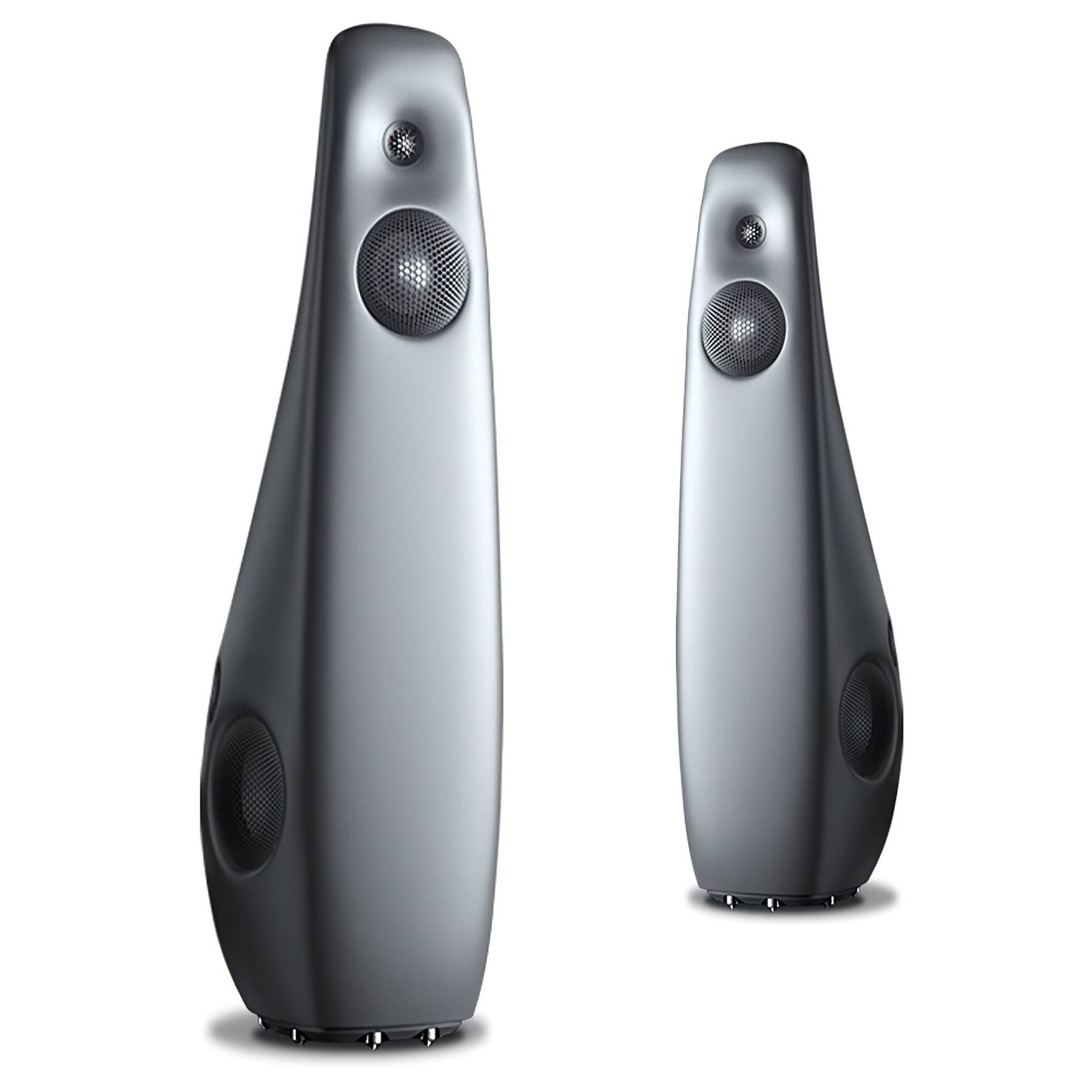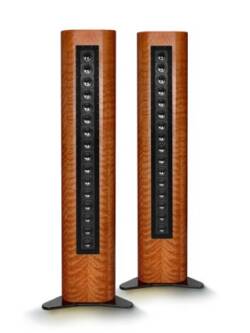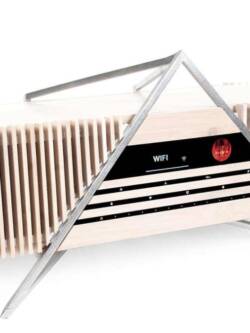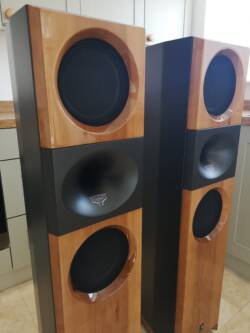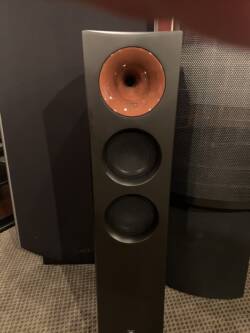Vivid Kaya 45 loudspeaker
Original price was: R308,000.00.R165,000.00Current price is: R165,000.00.
| Specifications | Vivid Audio KAYA 45 |
|---|---|
| Configuration | 3 way 4 driver system |
| Cabinet material | Glass reinforced Soric-cored sandwich composite |
| Cabinet colour | Piano Black, Lexus Pearl White, Oyster Matte |
| Bespoke colour | Any PPG automotive colour available on request |
| Drive units | HF: D26 – 26mm Tapered Tube loaded alloy dome MF: C100se – 100mm Tapered Tube loaded alloy dome LF: C125L – 2 x 125mm alloy cone unit |
| Bass loading | Exponentially Tapered Tube enhanced bass reflex |
| Sensitivity | 89dB @ 2.83VRMS at 1m on axis |
| Nominal impedacnce (Ω) | 4Ω (2.8Ω Min) |
| Frequency range (Hz) | 37 – 25,000 Hz (-6dB) |
| First D26 Break Up mode: | 44,000 Hz |
| Harmonic distortion (2nd and 3rd harmonics) |
< 0.5% over frequency range at 1W |
| Cross over frequencies (Hz) | 300 – 3,000 |
| Recommended amplifier power | 25W – 500W |
| Loudspeaker dimensions | 1,153mm (H) x 298mm (W) x 385mm (D) |
| Net weight | 25kg |
| Shipping dimensions | 1,245mm (H) x 680mm (W) x 450mm (D) |
| Shipping weight | 60kg (pair) |
Description
This is an EXTRODINARY speaker! No wonder the world press goes nuts!!!

For a decade, the sound of the Vivid Giya loudspeakers, which I had heard only at CES in private demonstration suites, beguiled me. My positive impressions were completely consistent from one show to the next—but then, so were the host and the surroundings. I had to wonder how much those factors contributed to my impressions.I had a similarly positive reaction to the sound of the new Vivid Kaya speakers in a tiny demo room on the show floor at the 2018 High End Show in Munich. Smaller and simpler in appearance than Vivid’s flagship Giyas, the Kayas are also significantly less expensive, even though they incorporate the same major design features. When Art Dudley and I sat down to talk about the Kayas with Vivid’s Laurence Dickie and Philip Guttentag, I pushed to get a pair for review.
After dallying, as a young man, with KEF B139 bass drivers in transmission lines, Dickie went to work at Bowers & Wilkins and developed a means of loading drivers with exponential tapered tubes. This culminated, in 1991, with the prototype of the B&W Nautilus loudspeaker system, which saw its commercial release in 1993, and which remains an iconic product for B&W. Dickie left B&W in 1997, and, in 2004, after a few years working overseas, cofounded Vivid Audio. There he combined his commitment to the use of exponential tapered tube loading with the use of synthetic materials for cabinet construction and in-house driver design and assembly. Vivid introduced the Giya G1 in 2008.
The Vivid Kaya is available in three different floorstanding models: the two-way Kaya 25 and the three-way Kaya 45 and Kaya 90. For me, choosing to review the Kaya 45 ($18,000/pair) over the 90 was somewhat arbitrary. They share the same midrange and treble drivers and the same overall design, construction, and appearance. The 45 is smaller, with only a pair of 5″ woofers per speaker rather than the quartet of same in each Kaya 90. I thought these must be some special 5″ drivers and wondered how just a pair could work in this line of high-concept floorstanders.
I felt an immediate affinity with the size and shape of the 45 because it conjured up visions of Al Capp’s legendary cartoon character the Shmoo. Capp depicted this sympathetic and benign friend of humankind as a mustachioed, armless biped shaped like a bowling pin. Shmoos were said to be more entertaining than TV or movies, and they were excellent playmates for children. That’s probably too much to expect of a loudspeaker, even one that looks like a Shmoo in a piano-black tuxedo, but the Kaya 45s were welcome guests in my living room.
Delivery and setup
The two Kaya 45s arrived in a single wooden crate with a pair of wheels and a pair of handgrips on opposite ends: The crate can be moved by a single person without the need for a handtruck or dolly. Inside, each Kaya is cradled face-up and attached to a small plywood panel with handgrips at its base. It was actually pretty easy to lift the speaker out of the box and into position. Very Shmoo-like so far.

Pictures of the Kaya 45 convey more information than I could possibly put into words, but I can say that this 45″-tall speaker is quite sleek and will blend in with a wide range of furnishing styles—although it will attract the attention of new visitors. That said, with or without the removable grilles for their midrange and bass drivers, the Kayas look graceful: They don’t scream audio! or tech!
A single pair of multiway speaker posts, placed close together at the extreme bottom of the rear surface—sort of under the Kaya’s “derriere”—are inconspicuous. The enclosure itself is constructed of a glass-reinforced sandwich composite described by Vivid as “soric-cored.” The material’s thickness varies to minimize mass where it is not needed but to endow other portions exposed to higher pressures with more mass, to prevent panel movement. The finish quality of this seamless skin was superb.

As one would expect from Vivid, every driver is loaded with an exponentially tapered tube; while those for the tweeter and midrange are closed, the bass tube travels up and down internally, terminating in a pair of reflex ports. These ports are positioned symmetrically, slightly above and behind each of the woofers. Symmetrical side-mounted woofers are not unusual, but the drivers are physically braced to each other to further cancel extraneous vibrations due to their motion. Furthermore, the symmetrical placement of the ports ensures that internal pressures are balanced to minimize re-radiation of signals from the cabinet. While playing a bass-heavy recording, I ran my hands over the Kaya and could not discern any vibrations. When I put my hands close to the two ports, there was the weirdest perception of the Kaya blowing out of both sides in perfect synchrony.

Once in position, the user has the option of employing the six floor spikes for carpet placement or the six polyamide feet for delicate hard floors. On my carpet, I used the spikes and followed Vivid’s simple but detailed instructions for setting them up. The Kayas ended up about 7′ from the wall behind them, about 7′ apart, and 4′ and 3.5′ from the left and right walls, respectively. I aimed the Kayas straight ahead—ie, without any toe-in—and the distance between each speaker and my main listening position was 8.5′. Each Kaya was connected to its own Benchmark AHB2 power amplifier, operated in monoblock mode.

My initial impression was of a clear midrange and treble—and, at the bottom end, a notable degree of richness that didn’t so much affect the sounds of the instruments as convey the ambiance of the recording studio: an effect I find to be more common with much larger speakers than these. However, as I played an assortment of recordings, the delightful sparkle of the treble began to seem persistently highlighted and I readjusted the toe-in so that the speaker axis aimed directly at my listening seat. Snap! The midrange came up in perfect balance with the treble. (Vivid’s setup suggestions do recommend that orientation, expressly in order to reduce reflections off the side walls.)
Listening impressions
The Kayas were marvelous in their rendering of voices, individual and massed. I did a historical survey of recordings by Dame Emma Kirkby, whose career spans decades. Beginning with her early recordings of Mozart’s Exsultate, Jubilate in 1984 (CD, L’Oiseau-Lyre 168055) and Hildegard von Bingen’s O Jerusalem in 1982 (CD, Hyperion CDA66039) through Dowland’s “Flow, My Tears” in 2005 (SACD, BIS BIS-1475) and 2017 (SACD, BIS BIS-2283), her unique sound has changed less over the years than have the recordists who work with her and the technologies at their disposal. The clarity of the Kaya 45s made the technical differences so explicit and allowed me to hear through them to that same wonderful and unique voice. Even the Mozart from ’84 sounded neither too bright nor too close, as it is on some speakers: It was well balanced if a bit distant compared to the recordings made in this century.
